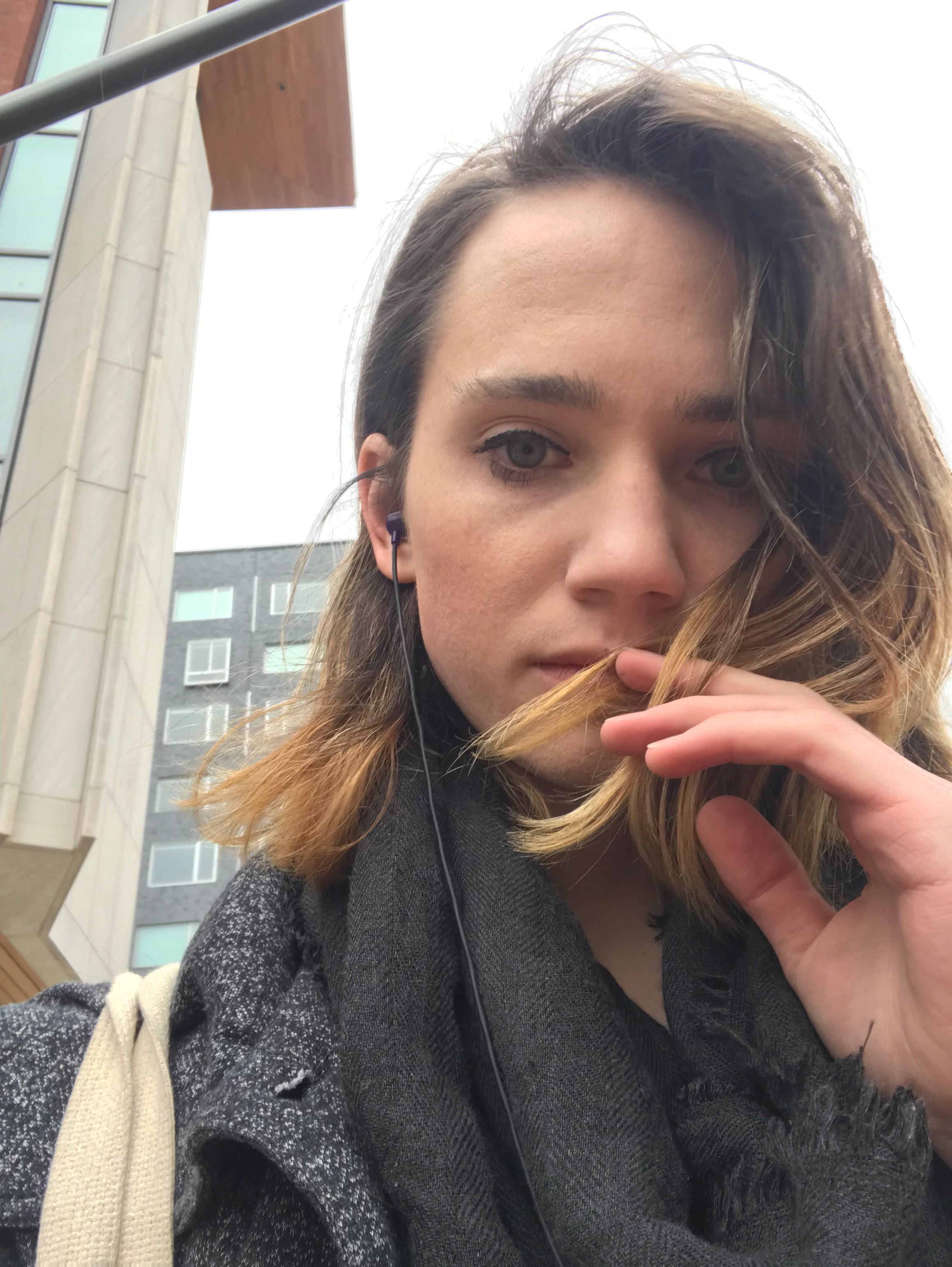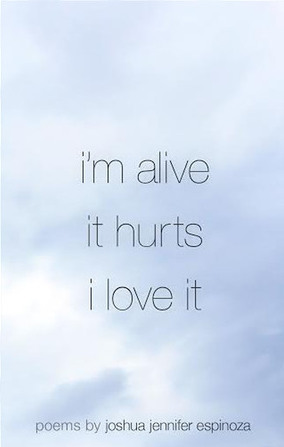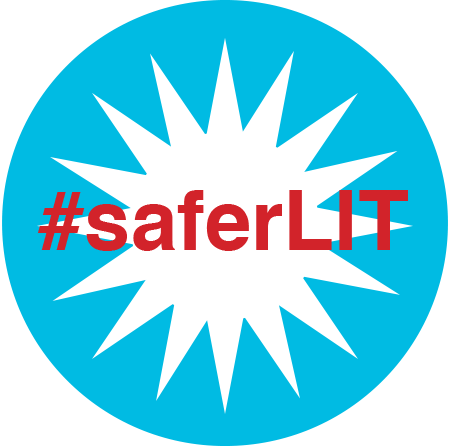ISSN: 1941-4137
POETRY THAT ENACTS THE ARTISTIC AND CREATIVE PURITY OF GLASS
POETRY THAT ENACTS THE ARTISTIC AND CREATIVE PURITY OF GLASS

Faye Chevalier is a Philadelphia-based poet and essayist. She is the author of the chapbooks future.txt (Empty Set Press 2018) and flesh_wound (Accidental Player Press 2020), and her work has been featured in The Wanderer, Peach Mag, Yes Poetry, the tiny, and elsewhere. Some of her awards and recognitions include being the first poet ever to have work published in a cyberpunk tabletop rpg podcast (Neoscum 2018) and also a Pushcart nomination. Find her on Twitter where she cries about River Phoenix & having a body at @bratcore.
November 5, 2019
Edited by Stephanie Kaylor
Edited by Stephanie Kaylor
Review of I’m Alive. It Hurts. I Love It. by Joshua Jennifer Espinoza
 I’m Alive. It Hurts. I Love It.
by Joshua Jennifer Espinoza
Big Lucks, 2019
Joshua Jennifer Espinoza’s I’m Alive. It Hurts. I Love It. (Big Lucks, 2019) is a collection of foldings and enfoldings, a bloody exposition of subjectivity and distaste that is unafraid to turn in on and question the nature of the lines that delineate and separate them. The deceptive simplicity of the collection’s opening line, “i’m several things,” establishes such curation as taking place within the shifting forms Espinoza’s speaker undertakes throughout the course of the collection (1). For Espinoza, for the trans women in her audience, reclamation and ruin live not as binary, but as cyclical; one curates a sense of purpose, self, and womanhood by collapsing one’s sense of them as solid “naturalized” ideals to be left untouched, for one to mold oneself to.
The self in I’m Alive. It Hurts. I Love It. is a whirling thing, the potential energy within the tensions between trans women and a world that wishes them dead. There is a joy in living in defiance of power, a celebration of not just softness but of the gory honesty and vulnerability of love amidst the apocalypse, of being “a sculpture of a goddess / accidentally carved into the side of a cliff / by millions of years of pounding ocean waves / so much pain and salt / so much water and life” (3). There is a fleeing comfort in facing the void, in the disturbance of enough-ness, of living in “…the vast space / between incomplete and complete,” for “i’ve built houses there that i can inhabit when i am sad. / i’ve memorized more and more of them each day.” (51).
And at the same time, within the celebration, within the joy, there lives an eerie cynicism when confronting the painfulness of vulnerability. The cold certainty that “my whole day is making myself feel / more like a ‘real’ girl / and less like a disintegrating one.” seemingly springs forth as a result of defying power (41). Such pain lives as an end to itself, formulating a vision of point(less)-ness of pain that haunts and enters Espinoza’s speaker’s hope in rupture and defiance. The pain of finding that “the space between ‘i feel like a woman’ / and ‘i don’t feel like i look like a woman’” is one that “lives without hope / in the pink mist / the brain fog / the god dark” — in other words, the very point(less)-ness of pain, its lack of momentum towards a realization of anything other than itself, warps the lines and aesthetics a body contorts itself to and against (28). Pain occurs in an ever-unfamiliar locale, “where the light from absence / acts like something else,” where the rules of being and performing, of feeling and looking, tense against one another until they come undone and become unintelligible from one another (28).
And, ironically enough, it is here where Espinoza thrives; where one may try to offer answers or personal empowerment, Espinoza offers potentiality. Where one might offer prescription or Maggie Smith-esque cheery faith in the void, Espinoza offers freedom. Liberation lies not in simply reveling in the dissonance between the lines of norms one confronts and one’s vision of oneself — rather, it lies in the abolition of such lines altogether, the releasing of the tension inherent within queer visions of jouissance by pouring its potentiality into the cracks in reality it produces. There is a wild, unpin-able joy in reclamation and rupture, of finding oneself with the power to “ruin everything completely / and make new bodies from the mess” for “nothing more beautiful than this / ever fell from anywhere” (47).
The bright mixture of violence, vulnerability, confusion, and joy one confronts within the pages of I’m Alive. It Hurts. I Love It., where Espinoza loudly proclaims “i swell, crash, laugh / let everything in my head crowd together.” come hand in hand with comfortable dissolution, the knowledge that “it all crumbles out when i exhale. / it keeps trying to fill what can’t be.” (33). To read I’m Alive. It Hurts. I Love It. is to confront and embrace the ways trans women make and unmake ourselves on a regular basis as a means of survival, of finding joy in a world that is not built to sustain us. For Espinoza, the purpose of vulnerability is not to confront metaphysical truths or hold oneself as ruin for the sake of finding redemption, but rather to find pathways to unmake shame and collapse-to-extend visions of being alive. I’m Alive. It Hurts. I Love It. is a truly magnificent slippery, painful, loud, violent, intricate, delicate, vulnerable, and, ultimately, freeing little object — let her dig under your skin and make a home in you.
Visit Joshua Jennifer Espinoza's Website
Visit Big Lucks' Website
I’m Alive. It Hurts. I Love It.
by Joshua Jennifer Espinoza
Big Lucks, 2019
Joshua Jennifer Espinoza’s I’m Alive. It Hurts. I Love It. (Big Lucks, 2019) is a collection of foldings and enfoldings, a bloody exposition of subjectivity and distaste that is unafraid to turn in on and question the nature of the lines that delineate and separate them. The deceptive simplicity of the collection’s opening line, “i’m several things,” establishes such curation as taking place within the shifting forms Espinoza’s speaker undertakes throughout the course of the collection (1). For Espinoza, for the trans women in her audience, reclamation and ruin live not as binary, but as cyclical; one curates a sense of purpose, self, and womanhood by collapsing one’s sense of them as solid “naturalized” ideals to be left untouched, for one to mold oneself to.
The self in I’m Alive. It Hurts. I Love It. is a whirling thing, the potential energy within the tensions between trans women and a world that wishes them dead. There is a joy in living in defiance of power, a celebration of not just softness but of the gory honesty and vulnerability of love amidst the apocalypse, of being “a sculpture of a goddess / accidentally carved into the side of a cliff / by millions of years of pounding ocean waves / so much pain and salt / so much water and life” (3). There is a fleeing comfort in facing the void, in the disturbance of enough-ness, of living in “…the vast space / between incomplete and complete,” for “i’ve built houses there that i can inhabit when i am sad. / i’ve memorized more and more of them each day.” (51).
And at the same time, within the celebration, within the joy, there lives an eerie cynicism when confronting the painfulness of vulnerability. The cold certainty that “my whole day is making myself feel / more like a ‘real’ girl / and less like a disintegrating one.” seemingly springs forth as a result of defying power (41). Such pain lives as an end to itself, formulating a vision of point(less)-ness of pain that haunts and enters Espinoza’s speaker’s hope in rupture and defiance. The pain of finding that “the space between ‘i feel like a woman’ / and ‘i don’t feel like i look like a woman’” is one that “lives without hope / in the pink mist / the brain fog / the god dark” — in other words, the very point(less)-ness of pain, its lack of momentum towards a realization of anything other than itself, warps the lines and aesthetics a body contorts itself to and against (28). Pain occurs in an ever-unfamiliar locale, “where the light from absence / acts like something else,” where the rules of being and performing, of feeling and looking, tense against one another until they come undone and become unintelligible from one another (28).
And, ironically enough, it is here where Espinoza thrives; where one may try to offer answers or personal empowerment, Espinoza offers potentiality. Where one might offer prescription or Maggie Smith-esque cheery faith in the void, Espinoza offers freedom. Liberation lies not in simply reveling in the dissonance between the lines of norms one confronts and one’s vision of oneself — rather, it lies in the abolition of such lines altogether, the releasing of the tension inherent within queer visions of jouissance by pouring its potentiality into the cracks in reality it produces. There is a wild, unpin-able joy in reclamation and rupture, of finding oneself with the power to “ruin everything completely / and make new bodies from the mess” for “nothing more beautiful than this / ever fell from anywhere” (47).
The bright mixture of violence, vulnerability, confusion, and joy one confronts within the pages of I’m Alive. It Hurts. I Love It., where Espinoza loudly proclaims “i swell, crash, laugh / let everything in my head crowd together.” come hand in hand with comfortable dissolution, the knowledge that “it all crumbles out when i exhale. / it keeps trying to fill what can’t be.” (33). To read I’m Alive. It Hurts. I Love It. is to confront and embrace the ways trans women make and unmake ourselves on a regular basis as a means of survival, of finding joy in a world that is not built to sustain us. For Espinoza, the purpose of vulnerability is not to confront metaphysical truths or hold oneself as ruin for the sake of finding redemption, but rather to find pathways to unmake shame and collapse-to-extend visions of being alive. I’m Alive. It Hurts. I Love It. is a truly magnificent slippery, painful, loud, violent, intricate, delicate, vulnerable, and, ultimately, freeing little object — let her dig under your skin and make a home in you.
Visit Joshua Jennifer Espinoza's Website
Visit Big Lucks' Website
Glass: A Journal of Poetry is published monthly by Glass Poetry Press.
All contents © the author.
All contents © the author.





